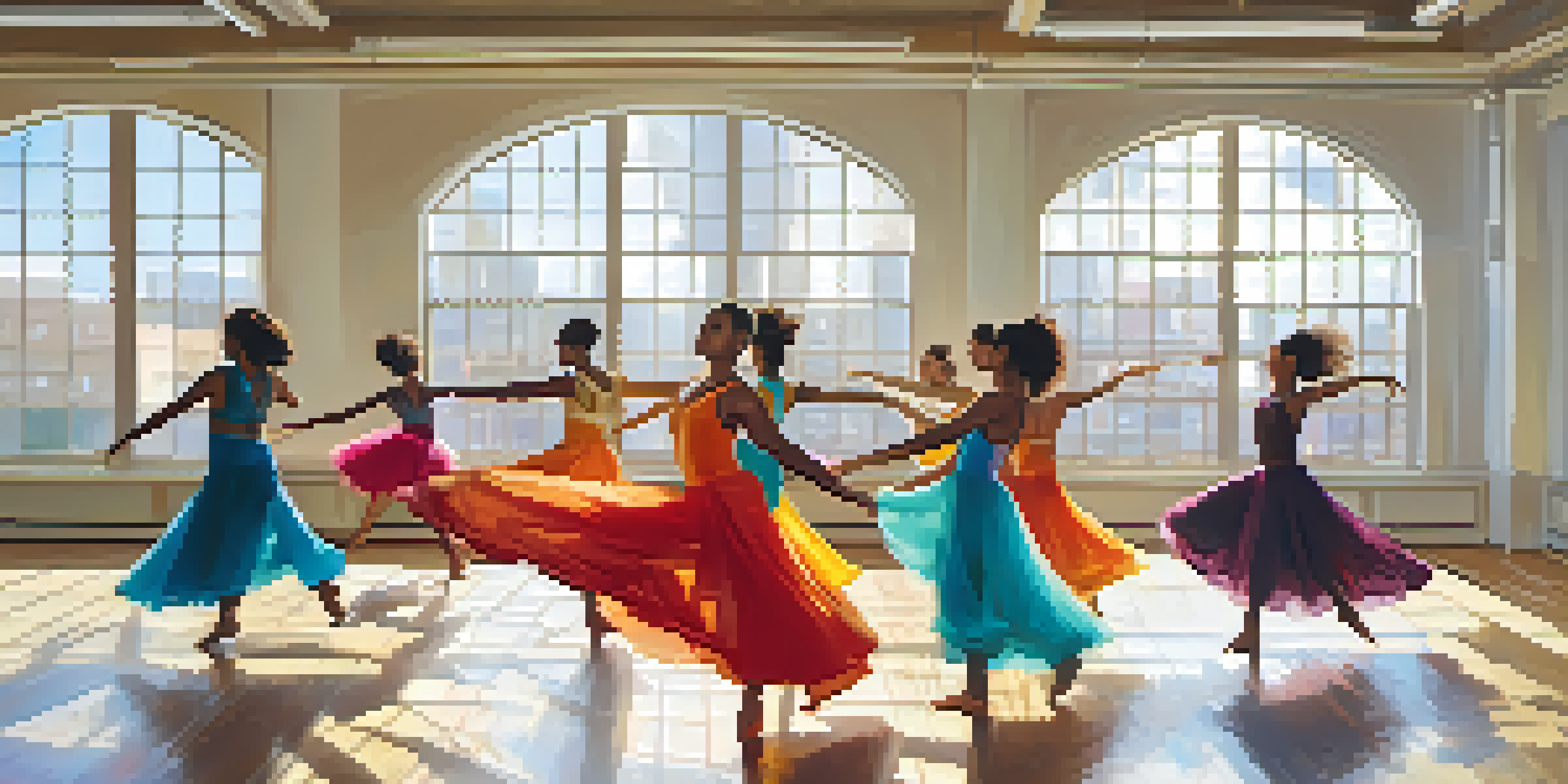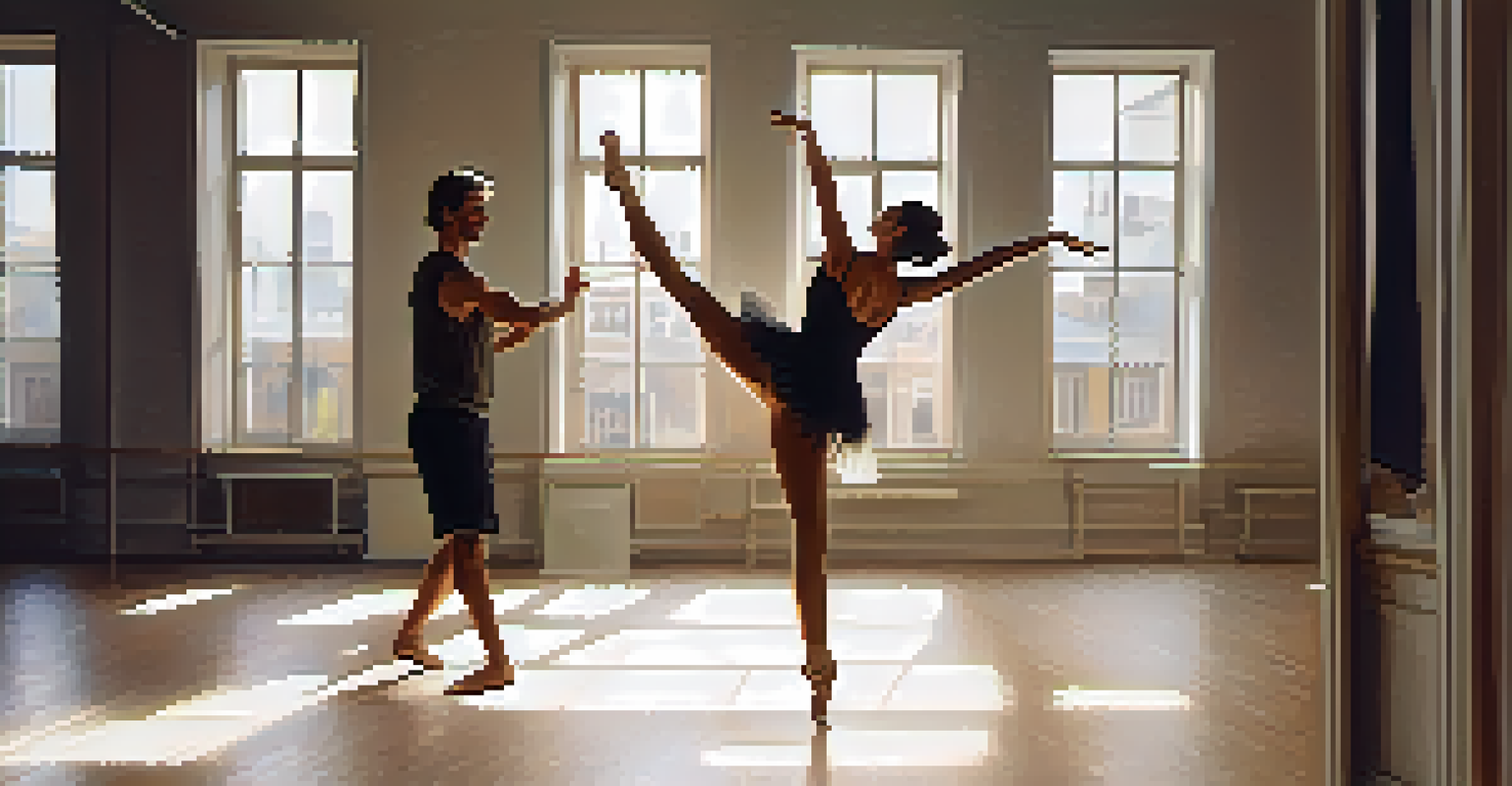Collaborative Dance Projects: Balancing Vision and Execution

Understanding the Essence of Collaborative Dance Projects
Collaborative dance projects bring together artists from diverse backgrounds, creating a tapestry of movement and expression. At the heart of these projects lies a shared vision, often inspired by themes, emotions, or narratives that resonate with the participants. This collective effort allows for a richer exploration of dance, pushing the boundaries of creativity and innovation.
The whole is greater than the sum of its parts.
However, collaboration can be tricky, as differing perspectives and styles may clash. It's essential for dancers to communicate openly, ensuring everyone's voice is heard while also being mindful of the overarching vision. This balance between individual expression and collective purpose is what makes collaborative dance so powerful.
Ultimately, understanding the essence of collaboration is about recognizing the unique contributions each dancer brings. By valuing these differences, projects can evolve into something greater than the sum of their parts, resulting in performances that are both cohesive and dynamic.
The Role of Vision in Dance Collaborations
A strong vision acts as a guiding star for any collaborative dance project, providing direction and inspiration. This vision often stems from the choreographer or lead dancer, but it should be flexible enough to accommodate input from all participants. When everyone shares a common goal, the creative process becomes more harmonious and focused.

Vision goes beyond just the choreography; it encompasses the emotions and messages the dancers wish to communicate. For instance, a project centered around social justice may inspire movements that reflect struggle and hope. By anchoring the creative process in a compelling vision, dancers can channel their energies toward a unified performance.
Collaboration Enhances Creativity
Collaborative dance projects blend diverse backgrounds, allowing for richer exploration of movement and expression.
Moreover, maintaining clarity in vision helps prevent conflicts that may arise during the execution phase. When everyone understands the intended message and purpose, it fosters collaboration and encourages dancers to explore their creative ideas while still aligning with the project’s goals.
Execution: Turning Vision into Reality
While a well-defined vision is crucial, executing that vision is where the real artistry comes into play. This phase involves translating ideas into movement, which requires not only creativity but also a structured approach to choreography. Dancers must work together to refine their movements, ensuring they align with the shared vision.
Dancing is creating a sculpture that is visible only for a moment.
It's also important to establish clear roles and responsibilities within the group, which can facilitate smoother execution. For example, assigning tasks like music selection, costume design, and rehearsal scheduling helps streamline the process. This division of labor allows each dancer to focus on their strengths, enhancing the overall quality of the performance.
Furthermore, regular check-ins during rehearsals can help the team stay on track, allowing for adjustments as needed. This dynamic approach helps ensure that the final product is not only true to the vision but also incorporates the unique flair of each dancer involved.
Challenges in Collaborative Dance Projects
Collaborative dance projects, while rewarding, come with their own set of challenges. Differences in artistic vision, communication styles, and work ethics can create friction among team members. Recognizing and addressing these challenges early on is crucial to maintaining a positive collaborative environment.
For instance, if a dancer feels their ideas are overlooked, it can lead to frustration and disengagement. Therefore, fostering an atmosphere of respect and open dialogue is essential. Regular discussions about individual contributions and feelings can help preempt conflicts and ensure everyone feels valued.
Vision Guides Collaborative Success
A strong and flexible vision unites dancers, ensuring alignment in their creative process and preventing conflicts.
Moreover, time constraints and logistical issues can also pose significant hurdles. Balancing the availability of dancers with rehearsal schedules requires careful planning and flexibility. Acknowledging these challenges and approaching them with a solution-oriented mindset can help teams navigate the complexities of collaboration more smoothly.
The Importance of Feedback in Collaboration
Feedback is a vital component of any collaborative dance project, serving as a bridge between vision and execution. Constructive criticism allows dancers to refine their movements and expressions, ensuring they align with the project's goals. However, it's essential that feedback is delivered in a supportive and respectful manner to foster a positive atmosphere.
Encouraging a culture of feedback means inviting all dancers to share their thoughts and experiences openly. This can be done through regular feedback sessions where dancers can discuss what’s working and what needs improvement. This collaborative dialogue not only enhances the performance but also builds trust among team members.
Additionally, embracing feedback promotes continuous learning and growth. Dancers who feel comfortable sharing and receiving critiques are more likely to take creative risks, leading to innovative and impactful performances. Ultimately, feedback enriches the collaborative process, ensuring that every voice contributes to the artistic journey.
Celebrating Diversity in Dance Collaborations
One of the most enriching aspects of collaborative dance projects is the diversity of backgrounds, styles, and experiences that each dancer brings. This variety not only enhances the creativity of the performance but also fosters a deeper understanding of different cultures and perspectives. Embracing diversity allows the project to explore a wider range of themes and movements.
For instance, incorporating various dance styles, such as ballet, hip-hop, and contemporary, can create a visually stunning and unique performance. This blend of styles encourages dancers to step outside their comfort zones, resulting in innovative choreography that captivates audiences. Moreover, it reflects the interconnectedness of our global community.
Feedback Fuels Artistic Growth
Constructive feedback fosters a supportive environment, enabling dancers to refine their performance and take creative risks.
Celebrating diversity also extends to the themes and narratives explored in the project. By addressing issues like identity, heritage, and social justice, the performance can resonate with a broader audience. This not only enriches the artistic expression but also fosters empathy and understanding through the universal language of dance.
Final Thoughts: The Harmony of Vision and Execution
In conclusion, the success of collaborative dance projects hinges on the delicate balance of vision and execution. A clear vision provides the foundation, while effective execution brings that vision to life. Both elements must work in harmony to create a cohesive and powerful performance that resonates with audiences.
As dancers navigate the challenges and joys of collaboration, it's essential to foster a culture of communication, respect, and creativity. By embracing feedback, celebrating diversity, and maintaining a shared vision, teams can overcome obstacles and produce work that is both innovative and impactful.

Ultimately, the beauty of collaborative dance lies in the journey itself. The process of creating together enriches not only the final performance but also the relationships between the dancers, leaving a lasting impact that goes beyond the stage.